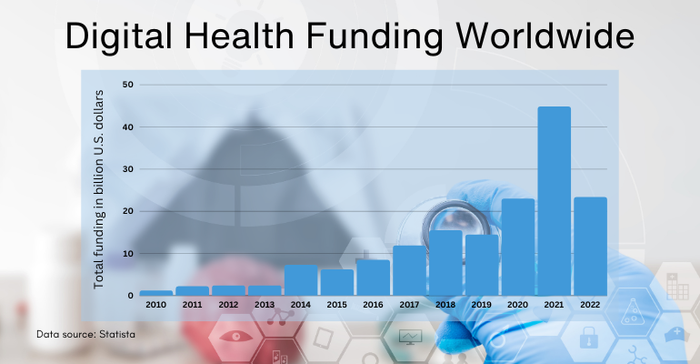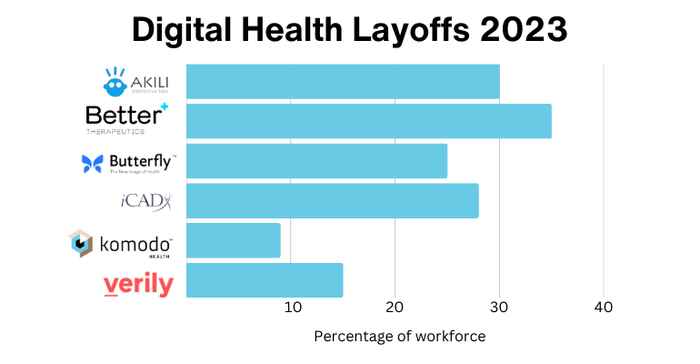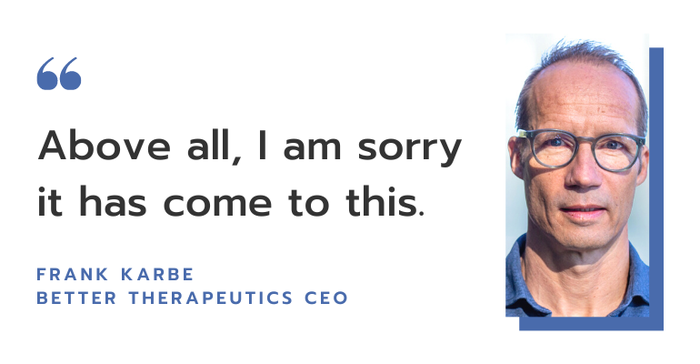Digital health layoffs intensify as funding nosedives.
March 29, 2023

After shattering funding records in 2020 and 2021, the digital health sector saw a sharp drop in investment dollars last year by comparison, according to Statista.
Combine that trend with an increase in layoffs across the sector (as well as the broader medtech industry), and we find ourselves asking: has the digital health bubble popped?
Granted, the sector still raised an impressive $23.3 billion in 2022, but compared to the $44.8 billion raised in 2021, digital health funding does appear to be cooling off. So, as “Late Night” host Seth Meyers would say, it’s time for a closer look.
Where’d the digital health funding go?

CB Insights’ State of Digital Health 2022 report shows a slightly different funding figure for the year (compared to Statista’s data) of $25.9 billion. Still, that marks a 57% drop from 2021’s record numbers, the firm noted.
Perhaps the more concerning trend highlighted in the report, however, is that funding declined over four consecutive quarters to reach $3.4 billion in the fourth quarter of 2022, a five-year low. Deals to the sector also hit a new low after falling 33% year-over-year, according to the CB Insights report. It was also the first quarter since 2018 to see no new companies achieve unicorn status (privately held company valued at $1 billion or more).
The layoff reaper targets digital health sector
The chart below depicts just the digital health layoffs reported in 2023, and does not include digital wellness companies, mental health telehealth service providers, or other companies providing telehealth services.

Pear starts to ooze
Prescription digital therapeutics trailblazer (PDT) Pear Therapeutics first began pruning its workforce in July 2022, letting go of about 25 employees, or 9% of the company’s full-time workforce as of July 25. A few months later, Pear trimmed another 22% of its workforce in a round of layoffs that impacted about 59 employees.
“Our pipeline of product candidates continues to represent significant potential, long-term value,” Pear CEO Corey McCann said during the company’s third-quarter earnings call in November, after announcing the second round of layoffs. “Leveraging our dual platforms, PearCreate and PearConnect, we have the opportunity to own the space we created, but we need to balance that opportunity with the current market landscape and our driving our business towards sustainability.”
Now the PDT darling is seeking help in the form of an acquisition, company sale, merger, divestiture of assets, licensing, and/or additional financing. If unsuccessful, Pear may be looking at more layoffs, a reorganization, liquidation, or other restructuring.
With about $84 million in cash, cash equivalents, and short-term investments, BTIG medtech analysts project Pear has a cash runway out to the third quarter of this year.
“We were encouraged by Pear’s shift last year to a more focused commercial strategy, reduced spending, improving prescription metrics, and a flurry of recent payer and access wins that increased patient access to the company’s core prescription digital therapeutics,” Marie Thibault, a medtech analyst at BTIG and a former MD+DI managing editor, wrote in a March 17 report.
She notes that PDTs are complimentary to, not competitive with, other treatment options. So, for example, Pear’s platform for developing and scaling a pipeline of PDTs could be of interest to any company looking to invest in the still-nascent digital medicines segment, Thibault pointed out.
“Our mission remains making software mainstream medicine, and we are steadily making that a reality,” McCann said during the November earnings call. “No one asks anymore if PDTs will become mainstream medicine. Now they ask when.”
Unfortunately, Thibault said any potential sale to come out of this is likely to be priced at a steep discount due to the company’s plunging stock price following the announcement earlier this month.
For ‘better’ or worse …

Another sign of trouble for the digital health market (specifically the PDT space) came this week when Better Therapeutics laid off 35% of its workforce.
“Layoffs are devastating for everyone. As CEO, I take responsibility,” CEO Frank Karbe wrote in a letter to employees that was included in the company’s filing with the Securities and Exchange Commission. “While this does not ease the pain, I recognize today was an extremely difficult day. We built this company on the foundations of transparency and trust, so it is important I share the background for these decisions. Above all, I am sorry it has come to this.”
This comes despite the company’s many milestones in 2022, including FDA submission seeking de novo authorization for BT-001.
“If authorized, BT-001 would become the first prescription digital therapeutic for the treatment of type 2 diabetes in adults,” Karbe said during the company’s third-quarter earnings call in November.
iCad makes deep cuts, explores ‘strategic options’ for Xoft
Digital Health also suffered another blow this week as AI mammography company iCad disclosed a 28% workforce reduction (about 23 employees), predominantly from its detection business. The company’s cancer therapy subsidiary, Xoft, also furloughed 50% of its workforce (12 employees). The company is also looking to shed Xoft.
The news comes just a few months after Google chose iCad as its mammography AI partner via a technology license. It also follows on the heels of an abrupt leadership transition as CEO Stacey Stevens steps down and Dana Brown takes her place in the corner office.
“While both the therapy and detection lines of business have great market opportunity and potential, we believe our core competencies and focus need to be solely on detection and our strategy around AI,” Brown said during the company’s fourth-quarter earnings call Tuesday.
BTIG’s Thibault wrote in a report Tuesday evening that the pledge to reduce spend and reach profitability is encouraging, but she is skeptical that revenue can grow meaningfully near-term given the deep cuts to the workforce, exploration of strategic options for the Xoft business, and iCad’s continued shift toward a subscription sales model.
“There are still positives to the iCad story, and we remain constructive because of what we believe is superior detection technology, strong partnerships with collaborators and enterprise customers, a relatively low cash burn, and the potential for funding via a possible Xoft deal,” Thibault wrote.
About the Author(s)
You May Also Like




